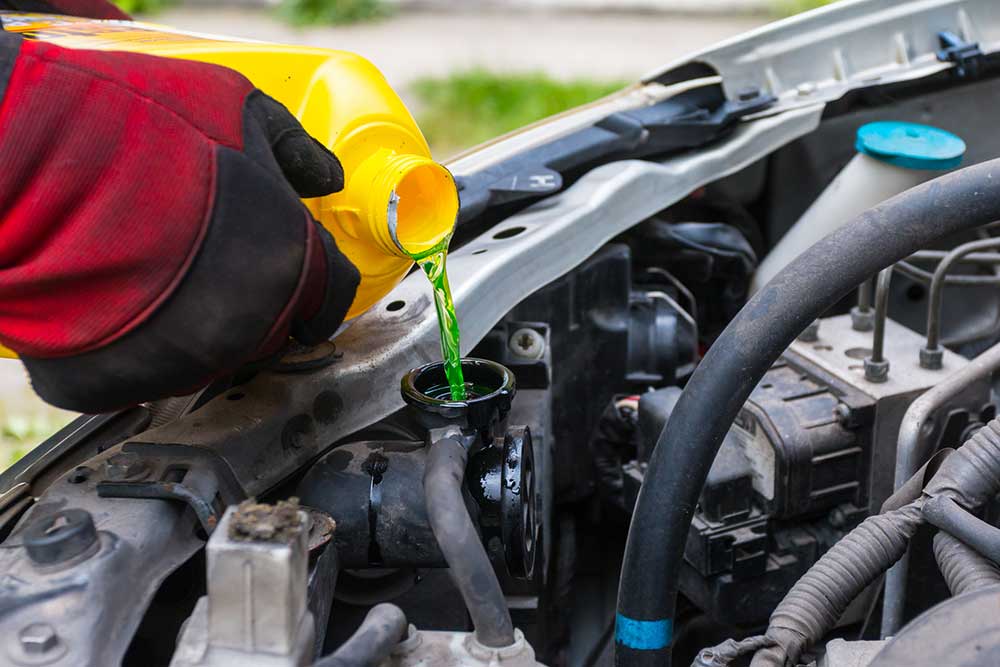Take Care of Your Car's Cooling System
- By Admin
- •
- 20 Apr, 2019

All automobiles contain cooling systems that regulate engine temperature. Your cooling system uses fluid to absorb heat and carry it to your radiator. The radiator's metal fins then help this heat disperse into the surrounding air. Despite this relatively simple process, numerous things can keep your cooling system from working correctly.
Many common problems can stem from the fluid - or lack thereof - in your cooling system. To keep your car in great condition, use the following information to choose appropriate cooling fluid and maintain your cooling system.
Many common problems can stem from the fluid - or lack thereof - in your cooling system. To keep your car in great condition, use the following information to choose appropriate cooling fluid and maintain your cooling system.
Radiator Fluid Is a Mixture of Anti-Freeze and Water
Once upon a time, automobiles used only water as their cooling fluid. And water can effectively absorb heat. Yet this capability ultimately makes water prone to problems when temperatures get too hot - or too cold. Too much heat causes water to boil, at which point it loses most of its ability to transfer heat.
Even more severe problems ensue when temperatures get too cold. A car with only water in its cooling system will suffer from freezing. A frozen cooling system does little for your engine and ironically may even contribute to overheating, since the water cannot flow into the radiator.
To solve this problem, today virtually all cars use a mixture of water and anti-freeze in their cooling systems. As its name suggests, anti-freeze lowers the freezing temperature of your radiator fluid. In addition, anti-freeze raises the boiling temperature of your fluid, allowing it to withstand hotter conditions.
Even more severe problems ensue when temperatures get too cold. A car with only water in its cooling system will suffer from freezing. A frozen cooling system does little for your engine and ironically may even contribute to overheating, since the water cannot flow into the radiator.
To solve this problem, today virtually all cars use a mixture of water and anti-freeze in their cooling systems. As its name suggests, anti-freeze lowers the freezing temperature of your radiator fluid. In addition, anti-freeze raises the boiling temperature of your fluid, allowing it to withstand hotter conditions.
Most Cars Need a 50/50 Mixture of Anti-Freeze and Water
In order for your car to function flawlessly, your cooling system must use the correct proportions of anti-freeze and water. For most cars, 50 percent of each fluid will yield sufficient protection against freezing and boiling. A 50/50 mix brings the freezing point down to around minus 35 degrees Fahrenheit while raising the boiling temperature to 223 degrees Fahrenheit.
In most climates, a 50/50 mixture provides a good balance between the heat-absorbing properties of water and the protective abilities of anti-freeze. However, in certain cases, mechanics increase the amount of anti-freeze up to 70 percent. Higher levels of anti-freeze provide additional protection for those who live in especially cold regions.
Unless you've been told otherwise, your car probably performs best with a 50/50 mix. To learn the ideal mixture for your vehicle, consult your owner's manual and your mechanic.
In most climates, a 50/50 mixture provides a good balance between the heat-absorbing properties of water and the protective abilities of anti-freeze. However, in certain cases, mechanics increase the amount of anti-freeze up to 70 percent. Higher levels of anti-freeze provide additional protection for those who live in especially cold regions.
Unless you've been told otherwise, your car probably performs best with a 50/50 mix. To learn the ideal mixture for your vehicle, consult your owner's manual and your mechanic.
Coolant Must Be Replaced Periodically
While coolant fluid lasts a long time, if a car's coolant levels drop too low, the cooling system cannot perform correctly. You can monitor your car's coolant level by visually inspecting the coolant reservoir beneath your hood. Most coolant reservoirs are semi-transparent, allowing you to easily see whether you have enough fluid.
If you don't have adequate fluid levels, add fluid as soon as possible. If you choose to do the job yourself, make sure you either buy an anti-freeze with the appropriate amount of water mixed in or mix the anti-freeze and water in the proper ratio yourself.
Even if your coolant remains at a safe level, you may need to have your system flushed and stocked with new fluid. Over time, the additives in anti-freeze break down, often causing deposits to form. Such fluid also has a harder time withstanding routine temperature changes.
Recommended coolant-change schedules vary from manufacturer to manufacturer, with some cars requiring coolant changes as frequently as every 30,000 miles. If you don't know how often to change your fluid, contact a professional. For more information about this or any other cooling system questions you may have, please contact the auto repair pros at Kell Radiator Service.
If you don't have adequate fluid levels, add fluid as soon as possible. If you choose to do the job yourself, make sure you either buy an anti-freeze with the appropriate amount of water mixed in or mix the anti-freeze and water in the proper ratio yourself.
Even if your coolant remains at a safe level, you may need to have your system flushed and stocked with new fluid. Over time, the additives in anti-freeze break down, often causing deposits to form. Such fluid also has a harder time withstanding routine temperature changes.
Recommended coolant-change schedules vary from manufacturer to manufacturer, with some cars requiring coolant changes as frequently as every 30,000 miles. If you don't know how often to change your fluid, contact a professional. For more information about this or any other cooling system questions you may have, please contact the auto repair pros at Kell Radiator Service.


